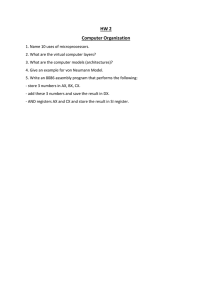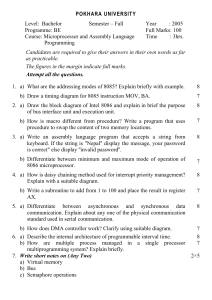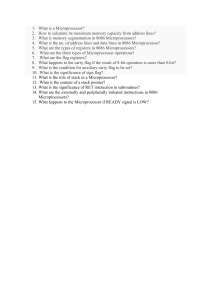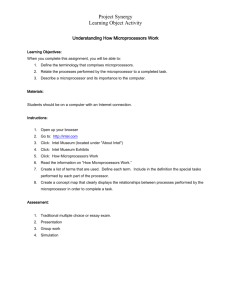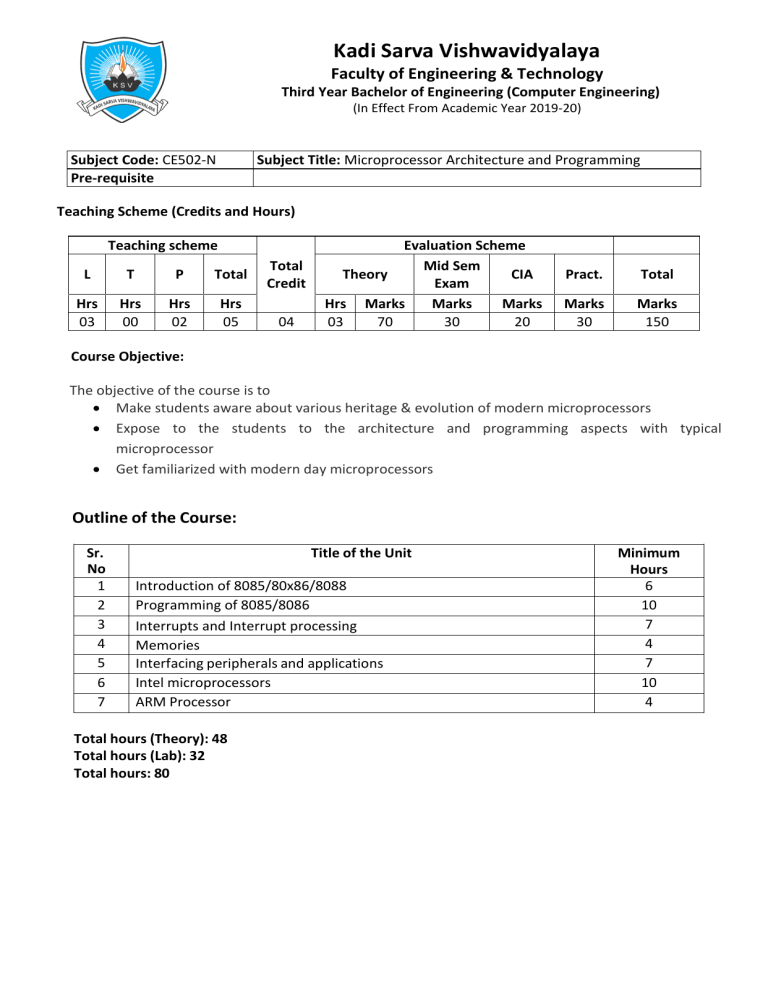
Kadi Sarva Vishwavidyalaya Faculty of Engineering & Technology Third Year Bachelor of Engineering (Computer Engineering) (In Effect From Academic Year 2019-20) Subject Code: CE502-N Pre-requisite Subject Title: Microprocessor Architecture and Programming Teaching Scheme (Credits and Hours) Teaching scheme L T P Total Hrs 03 Hrs 00 Hrs 02 Hrs 05 Total Credit 04 Evaluation Scheme Mid Sem Theory CIA Exam Hrs Marks Marks Marks 03 70 30 20 Pract. Total Marks 30 Marks 150 Course Objective: The objective of the course is to • Make students aware about various heritage & evolution of modern microprocessors • Expose to the students to the architecture and programming aspects with typical microprocessor • Get familiarized with modern day microprocessors Outline of the Course: Sr. No 1 2 3 4 5 6 7 Title of the Unit Introduction of 8085/80x86/8088 Programming of 8085/8086 Interrupts and Interrupt processing Memories Interfacing peripherals and applications Intel microprocessors ARM Processor Total hours (Theory): 48 Total hours (Lab): 32 Total hours: 80 Minimum Hours 6 10 7 4 7 10 4 Kadi Sarva Vishwavidyalaya Faculty of Engineering & Technology Third Year Bachelor of Engineering (Computer Engineering) (In Effect From Academic Year 2019-20) Detailed Syllabus Sr. No Topic 1 Introduction: Introduction to microprocessors and microcontrollers, system bus organization, 8085 architecture 2 Assembly Language Programming: Introduction to 8085 instructions, addressing modes, stacks and subroutines. Introduction to 16-bit and 32-bit microprocessors – 80x86 families. Assembly language programming for 8086/8088. 3 4 5 6 7 Interrupts and interrupt processing: Hardware and software Interrupts in 8085, 8086/8088. Interfacing memory: DMA, SRAM/DRAM, cache memory. Memory layout for 8086/8088. Virtual mode operation. Interfacing peripherals and applications: 8254-Programmable Interval timer/counter, 8255-Programmable Peripheral Interface, 8259-Programmable/Priority Interrupt controller. Digital interfacing – keyboards, displays, Analog interfacing – sensors, transducers 32-bit Intel microprocessors: The Intel 80286, 80386, 80486, Pentium and RISC based Intel MMX architecture. Real mode of 80386, Protected mode of 80386, Virtual 8086 mode. ARM family of processors: Overview of ARM architecture, Android-ARM hardware- software interface T ot al Instructional Method and Pedagogy: • • • • • • • Lecture Hours Weight age(%) 6 14 10 20 7 16 4 7 7 16 10 20 4 7 48 100 At the start of course, significance of the course, content delivery pattern, and other required details regarding subject will be discussed. Lectures will be conducted with the aid of multi-media projector, black board, smart boards etc. Attendance is compulsory in lecture and laboratory which will be reflected in Continuous Internal Assessment (CIA) component in the examination scheme of the course. Internal / Mid-semester examinations shall be conducted for theoretical evaluation. Assignments based on the course content will be given to the students and will be evaluated at regular interval evaluation. The course includes a laboratory, where students have an opportunity to build an appreciation for the concepts being taught in lectures. Experiments shall be performed in the laboratory related to course contents. The course includes a laboratory, where students have an opportunity to build and appreciation for the concepts being taught in lectures. Experiments shall be performed in the laboratory related to course contents. Kadi Sarva Vishwavidyalaya Faculty of Engineering & Technology Third Year Bachelor of Engineering (Computer Engineering) (In Effect From Academic Year 2019-20) Learning Outcome: After completion of the course students are expected to be able to: • Understand and communicate the architectural aspect of microprocessors along with primitive functionalities of various components in the same. • Interact with microprocessor with the code written in assembly language programming • Identify and analyze primitive hardware aspects and the instruction sets for various microprocessors e-Resources: • https://nptel.ac.in/courses/108107029/ Reference Books: 1. Microprocessor & Interfacing – Dauglas Hall, THM 2. Microprocessor Architecture, Programming, and Applications With the 8085, Ramesh Gaonkar, Prentice Hall. 3. Advanced 80386 Programming Techniques: James Turley. 4. Advance Microprocessor - Deniel Tabak. 5. The Intel Microprocessors (Eight Editions): Barry B. Brey. 6. The 8086 Microprocessor, Kenneth Ayala, Cengage Learning. 7. The 8088 and 8086 Microprocessors, Triebel & Singh, Pearson Education. 8. Computer Architecture & Organization, Subrata Ghoshal, Pearson Publication 9. ARM System Developer's Guide: Designing and Optimizing System Software Morgan Kauffman Publisher. 10 IBM PC Assembly Language & Programming, Peter Abel, PHI. List of experiments Sr. No 1 2 3 4 5 6 7 8 9 10 11 Name of Experiment Architecture of 8086 Microprocessor and Addressing modes of 8086 Microprocessor. To perform Assembly language program for Data transfer operations. To perform Assembly language program for Arithmetic operations. To perform Assembly language program for Logical operations. To perform Assembly language program for Bit Manipulation operations. To perform Assembly language program for String Manipulation operations. To perform Assembly language program for Iteration Control operations. To perform Assembly language program for Conditional Branch operations. To perform Assembly language program for Unconditional Branch operations. Assignment 1: Advanced Program/Code Assignment 2: Demonstrating the Interfacing various Components with Microprocessors
